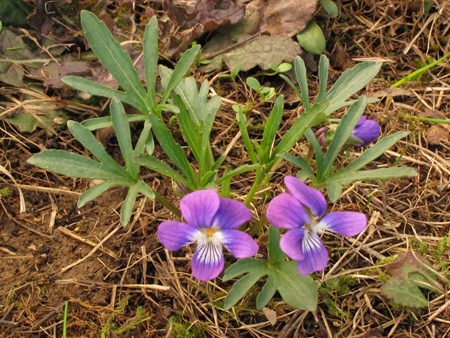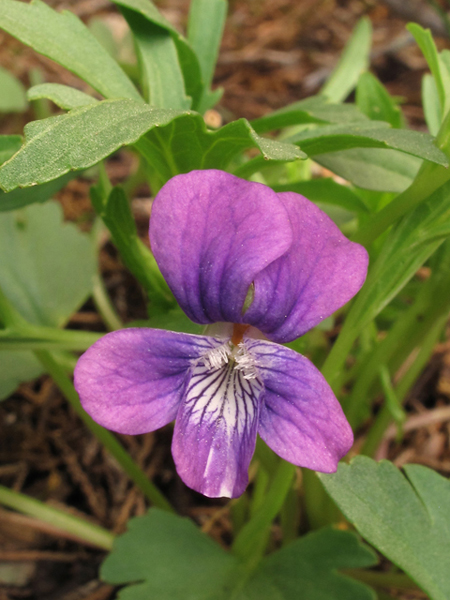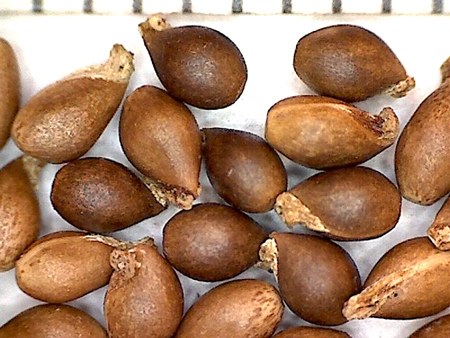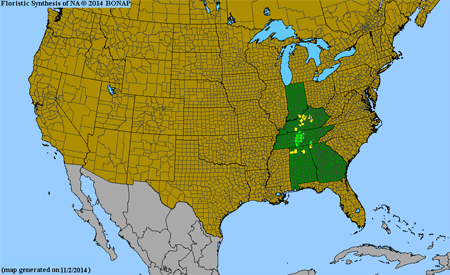Viola egglestonii Brainerd
Common names:
Eggleston's Violet
Synonyms:
Viola egglestonii Brainerd, Bull. Torrey Bot. Club 37: 526, pl. 34, 35. 1910; Viola septemloba Leconte subsp. egglestonii (Brainerd) L.E.McKinney, Sida, Bot. Misc. 7: 33. 1992. TYPE: Tennessee, [Davidson Co.] West Nashville, limestone barrens, 23 May 1909, W. W. Eggleston 4421 (HOLOTYPE: UVMVT024585!, internet image!).
Description:
Acaulescent rosulate perennials from thick rhizome, ≤ 29 cm tall; foliage and peduncles green, upper surface of leaf blades sometimes darker, glabrous throughout; stipules free, irregularly glandular-fimbriate; heterophyllous, leaves ascending, largest leaf blades moderately to deeply biternately divided into 7 or 9 lobes, terminal primary division distinctly narrowing proximally, the central lobe not much broader than its lateral lobes, ≤ 120 × 114 mm, outline ovate to subreniform, base broadly cuneate to subcordate, margins of lobes entire proximally and serrate distally, eciliate, apex sharply acute to obtuse; chasmogamous peduncle held among or above the leaves; chasmogamous flower ≤ 17 mm; calyx glabrous, eciliate or sparsely ciliate; lowest sepals lanceolate to ovate-lanceolate, obtuse to broadly rounded; auricles short and entire, not elongating in fruit; corolla blue to purple, white of throat extending onto lateral petals and halfway down spurred petal; lateral petals densely bearded with narrowly linear to slightly clavate hairs, spurred petal sparsely to densely bearded; chasmogamous capsule green; cleistogamous flowers produced after chasmogamous, the peduncle prostrate, arching just before capsule dehiscence, much shorter than petioles; capsule 12–18 mm, ovoid, green drying tan, unspotted, glabrous; seeds (1.8)2.7–3.3 × 1.3–1.7 mm, medium to dark brown, unspotted.
Similar species:
Among heterophyllous taxa, this species is most similar to others with glabrous foliage in our region, namely Viola edulis and Viola viarum in the Viarum species group. It differs in its more deeply biternately divided leaf blades with 7–9 long narrow lobes, the central lobe nearly or quite as narrow as the lateral ones, rounded sepals, bearded spurred petal, unspotted cleistogamous capsule on short prostrate peduncle, short auricles, unspotted brown seeds, and its habitat in limestone cedar glades of the Interior Plateau.
Ecology:
Dry rock crevices of limestone cedar glades (calcareous barrens), sometimes persisting in more disturbed sites overlying limestone such as pastures and roadsides. Also recently documented in lawns and plantings in cities and suburbs in southeastern Ontario and southwestern Quebec.
Distribution:
Interior Highlands, s. IN south to nw. GA and n. AL; disjunct and possibly introduced in s. ON and QC.
Rarity:
State listed in IN, KY [as V. septemloba var. egglestonii].
Phenology:
Chasmogamous flower April–May, chasmogamous fruit May–June, cleistogamous fruit July.
Affinities:
This species belongs to the Acaulescent Blue Violet lineage, sect. Nosphinium W.Becker, subsect. Boreali-Americanae (W.Becker) Gil-ad, in the Viarum species group.
Hybrids:
I have identified a herbarium specimen at CM from Rutherford Co., TN as a hybrid with V. sororia. It displayed intermediate characteristics of foliage traits. This is the first report of hybridization for V. egglestonii. No information is available on hybrid reproduction.
Comments:
Brainerd cited one specific collection as the type but did not reference a particular sheet. Gil-ad (1995, 1997) pointed out that Brainerd noted his intentions to supply types to NY; nevertheless, searches by Director Barbara Thiers, McKinney, Gil-ad and Ballard have failed to produce specimens at that herbarium. Gil-ad attributed the sole specimen to an isotype, but there is no indication that Brainerd ultimately distributed other specimens elsewhere. Since only the UVMVT024585 sheet exists, Ballard et al. (2020) accepted the sheet as the holotype.
Brainerd (1921b), Brainerd Baird (1942), Fernald (1950), Alexander (1963), Russell (1965), and Gil-ad (1995, 1997, 1998) accepted this narrow regional and edaphic endemic as a distinct species. Gleason and Cronquist (1991) synonymized it under V. palmata var. pedatifida (G.Don) Cronquist, while McKinney (1992) treated this as a subspeces under V. septemloba on the basis of similar leaf morphology. Little and McKinney (2015) later reinstated it at species rank. Although they look superficially similar, the two differ in certain vegetative features and many features of chasmogamous flowers, cleistogamous fruits and seeds, diverge in micromorphological features of the seeds, and have very different ecological niches. The two are maintained as separate species here.
Native populations occupy limestone cedar glades of the Interior Highlands as a regional endemic. Although it appears to persist in degraded limestone cedar glades, no information is currently available on whether the species expresses weedy tendencies or a proclivity for escaping into anthropogenic sites. However, populations tentatively referred to this species have been documented recently on iNaturalist at several sites in eastern Ontario and southwestern Quebec. The anomalous plants grow in suburban lawns and plantings, sometimes forming substantial populations and hybridizing with other species (e.g., V. communis). The disjunct and rather mysterious Canadian populations require further study.
Literature Cited:
Alexander, E. J. 1963. Violaceae. In Gleason, H. A., The new Britton and Brown illustrated flora of the northeastern United States and adjacent Canada. Hafner Publishing Co., Inc., New York, NY. 552-567.
Ballard Jr., H. E., R. N. Burwell, and S. L. Lockhart. 2020. Violaceae: Typifications and clarifications of names. In Weakley, A. S., D. B. Poindexter, H. C. Medford, B. A. Sorrie, C. A. McCormick, E. L. Bridges, S. L. Orzell, K. A. Bradley, H. E. Ballard, Jr., R. N. Burwell, S. L. Lockhart, and A. R. Franck. Studies in the vascular flora of the southeastern United States. VI. Journal of the Botanical Research Institute of Texas 14(2): 217-229.
Brainerd, E. 1921b. Violets of North America. Vermont Agricultural Experiment Station Bulletin 224: 1–172.
Brainerd Baird, V. 1942. Wild violets of North America. University of California Press, Berkeley, CA.
Fernald, M. L. 1950. Violaceae. In Gray’s Manual of Botany, 8th ed. American Book Company, New York, NY. 1022-1042.
Gil-ad, N. L. 1995. Systematics and evolution of Viola L. subsection Boreali-Americanae (W. Becker) Brizicky. Ph.D. dissertation. University of Michigan, Ann Arbor, MI.
Gil-ad, N. L. 1997. Systematics of Viola subsection Boreali-Americanae. Boissiera 53: 1–130.
Gil-ad, N. L. 1998. The micromorphologies of seed coats and petal trichomes of the taxa of Viola subsect. Boreali-Americanae (Violaceae) and their utility in discerning orthospecies from hybrids. Brittonia 50: 91–121.
Little, R. J., and L. E. McKinney. 2015. Violaceae. In Flora of North America: Cucurbitaceae to Droseraceae, 106. Oxford University Press, New York, NY.
McKinney, L. E. 1992. A taxonomic revision of the acaulescent blue violets (Viola) of North America. Sida, Botanical Miscellany 7: 1–60.
McKinney, L. E., and N. H. Russell. 2002. Violaceae of the southeastern United States. Castanea 67: 369–379.
Russell, N. H. 1965. Violets (Viola) of the central and eastern United States: An introductory survey. Sida 2: 1–113.

Chasmogamous flowering habit by Alan Cressler, "Lady Bird Johnson Wildflower Center" website

Cleistogamous fruiting habit by Harvey Ballard

Chasmogamous flower front view by Alan Cressler, "Lady Bird Johnson Wildflower Center" website

Seeds from herbarium specimen: Transplanted from TN, Davidson Co., West Nashville, E. Brainerd 44 (NY)

Map by Biota of North America Program